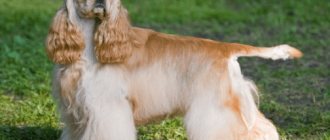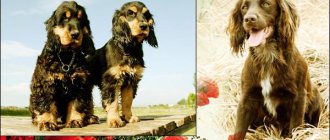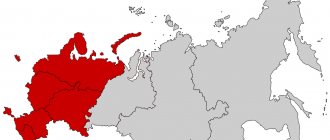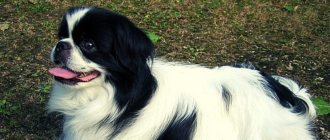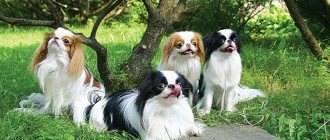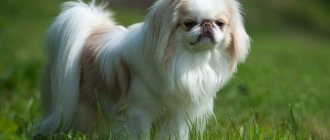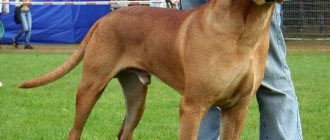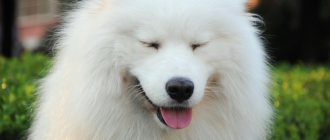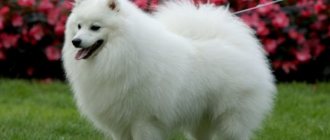The Japanese Chin or Japanese Spaniel is a decorative breed. This dog appeared in the East 1000 years ago and still retains its original appearance: slanting large eyes, neat body structure and long silky hair. A balanced character combined with intelligence complements the photo of the image of a companion dog.
History of the breed
The Japanese spaniel is considered a decorative pet bred in Japan. However, these dogs, which have become famous in many countries around the world, are not indigenous “Japanese”. The Chin's genealogy originates from the Tibetan Spaniel breed, and modern specimens are related to species such as the Pekingese and Cavalier King Charles Spaniel.
According to one of the main versions, the first individuals of the breed arrived in Japan in the 3rd century along with Buddhist monks who moved from China and India.
History of the Japanese Chin
The supposed ancestor of the Japanese Chin is the Tibetan Spaniel. They came to the Land of the Rising Sun in the 3rd century along with Buddhist monks from China and India. In 732, the ruler of the Korean state of Silla presented a pair of chins to the Japanese Emperor Semu. Initially, chins were favorites of the nobility; puppies were raised with special treatment in palaces. For example, in Ancient China they had their own servants.
The rulers gave these dogs as a sign of friendship. This is how the first chin came to Europe at the beginning of the 18th century as a gift to the wife of King Charles II of England. Soon they settled with the ladies of the court, and in the middle of the 19th century they came to America. Everywhere chins conquered with their originality, so the number in the West grew.
In Russia until the end of the 20th century there were only a few representatives of the breed. Only in the 80s did diplomats import decorative dogs with Japanese roots. Today in Russia there are at least 2,500 Chins with pedigrees, and throughout the world there are more than 20,000.
Interesting facts about Chin
Japanese Chins were favorites of such famous people:
- British Queen Victoria
- Nicholas II
- US President Franklin Pierce;
- Rothschild family;
- Marshal Zhukov.
Japanese women wore dogs of this breed in the sleeves of their kimonos. They were believed to bring harmony and happiness, and their breeding was kept in the strictest confidence.
Description of the breed
The Chinese Dwarf Chin is a graceful, small-sized dog. Features of the appearance of the breed include a wide muzzle and long hair. In males, the body size ratio is identical to the height at the withers parameter. But females have a more elongated body.
The dog's head is of a regular round shape, and the transition to the muzzle from the forehead is very sharp and deep. There are so-called pads above the upper lip. The nasal sinuses are clearly visible due to the wide and short bridge of the nose. The teeth of Chin individuals allow them to chew even the coarsest food. It is allowed to have a scissor bite rather than a straight bite. The ears are shaped like a hanging triangle. The surface is covered with wool. Thanks to the round and large shape of the eye sockets, these representatives of the breed always look interested.
The dog's chest is set deep and the belly is tucked. The back is straight and strong. The tail with luxurious long hair complements the overall picture of the breed.
The texture of the hair is similar to silk. The undercoat is poorly developed. Both ears should be decorated with symmetrical spots of red or black color. The eyes are located against a background of color identical to the ears. But spots on the body can be arbitrary and of absolutely any shape and size.
The height of a male dog at the withers is up to 25 cm in an adult. The female is 30 mm less. A mature dog can weigh from 1.8 to 3.2 kg.
Breed standard and description
Height at withers: up to 25 cm; Weight: 1.8-3.2 kg.
Color: black or red spots located symmetrically on a white background.
Eye color: black.
Nose: black or deep flesh-colored (only with red spots).
General appearance: a small dog with a short muzzle, graceful build, long single-layer hair, wide-set eyes, drooping ears.
Disqualifying faults:
- shy behavior;
- undershot;
- the lower jaw is curved;
- non-standard color of the nose;
- solid white color;
- a single spot on the head (there should be two symmetrical ones, preferably with a wide white stripe from the bridge of the nose to the forehead).
Breed standard
For each part of the body, the breed description has its own standards.
Head
The dog's skull should be round and wide. The bridge of the nose is massive and short. The lobe is located symmetrically to the eye line. The color matches the spots on the face and body. The teeth are strong (both straight and scissor bites are acceptable). The eyes are set wide apart and are always black without clouding. The ears are shaped like a triangle and are covered with long hair. The neck is short.
Frame
The back of the breed should be straight, and the loin should be wide with a slight rounding. Chest - set deep. The tail has abundant fur. The forearm of the forelimbs is thin-boned and straight. Moderate angulations can be seen on the hind legs. There is a lot of fur on both pairs of legs.
Paws
The pads of the Japanese Chin breed resemble the feet of a hare.
Wool
The richest element of the “design” of the Japanese Chin, which can hardly be called a disadvantage of the breed. Long and straight hair covers the body of this dog in an incredibly large volume. It resembles silk.
Colors
The ideal color for a Japanese Spaniel is white with small spots of red and black. In this case, the spots should be distributed symmetrically throughout the body of the Japanese Chin. It would also be preferable to have a wide white blaze starting from the bridge of the nose to the top of the head.
Character and appearance
These dogs are famous for their intelligence, agility, courage, cleanliness and pliability. Japanese Chins do not bark, and with their delicate communication manners they do an excellent job of maintaining a friendly atmosphere. When the owner is busy with his own affairs, the chin will not bother him, but will simply choose a wait-and-see attitude until the moment when they want to see him. The dog adapts perfectly to the lifestyle led by the owner. If a person prefers morning walks, then the chin will be happy to go outside. When the owner likes to spend more time at home, the pet will not disdain sitting on the sofa or in an armchair.
The Chin is wary of strangers and does not complain when they want to pet him.
Despite their size, representatives of the breed can cope with the functions of a house watchman. Owners can rely on their pets in this matter.
On the one hand, this dog is cheerful, open to people, and loves those around him. On the other hand, the Japanese Chin is unhappy if its contribution to the family is not high. You can ruin a dog’s character only by lack of attention, love, and by exerting physical force on it. If you approach raising a dog without the slightest idea about this process, it will begin to show aggression even towards its owner.
Dog Breeds Similar to Japanese
Korean Jindo (Korean Jindo)
Breed characteristics . The energetic Chindo can be both a shepherd and a hunter. These dogs are protected by Korean law and cannot be taken out of the country. In appearance, they resemble an Akita, but differ in head shape, coat texture, and color variations (gray, brindle, fawn, black and tan, and milk and tan).
Education and care . Very active pets who love to run and play. If you leave Chindo unattended for a long time, he will begin to spoil things, he may dig under the ground or jump over a fence or partition. The dog needs to be brushed constantly, but he doesn’t like to bathe.
Character . These are brave, hyperactive and smart animals. They are intolerant of other dogs and merciless in a fight. They are wary of strangers, but they love their owner deeply and selflessly.
Puppies . Chindo needs to be trained from childhood, otherwise he may grow up too willful and uncontrollable. Kids are energetic, love outdoor games and train with interest.
Chow chow
Breed characteristics . Despite its massive build, the Chow Chow is a medium-sized dog: its weight reaches 32 kg, and its height is 56 cm (male) and 51 cm (female) . Chow chows appeared in China, but the breed was improved in Great Britain. Its distinctive features are its blue tongue and gums, its peculiar gait, and its lion-like appearance.
Education and care . This dog is not very active, but daily walks are required. Not inclined to bark and howl, spoil things when left alone. Due to the thick undercoat, loose hair remains on the dog and can form mats, so it is important to comb your Chow at least three times a week.
Character . The Chow Chow is serious, does not like strangers, is independent and stubborn. Chow Chows are not playful and do not get along well with children. Chows are difficult to train.
Puppies . The first month the chow's tongue is pink, it darkens over time. A baby Chow should be bold, curious and playful.
Thai bangku (bangkaew, bangkeo, bankkew)
Breed characteristics . This is a representative of the Asian Spitz from Thailand. A medium-sized dog (its weight reaches 26 kg, and its height is 55 cm (male), 50 cm (female ). In the 1980s, the bangku almost became extinct, but the population was restored by enthusiasts.
Education and care . Bangku is an excellent watchdog, vigilant, trainable, and territorial. They require a lot of attention and patience: left to their own devices, this dog is capable of damaging furniture, wallowing in the dirt, and digging the ground. He needs long walks and early socialization.
Character. Bangku are smart and loyal to one owner (this makes them similar to Japanese dogs), but at the same time they are very jealous and vindictive. These animals have a good memory, and they always try to take revenge for the harm caused. They often show aggression towards those who are considered competitors in the fight for the owner’s attention.
Puppies . The kids are playful, active, and well trained. They need to start training as early as possible in order to smooth out negative character traits, then little bangkus will grow into faithful guards and smart companions.
Japanese dog breeds are varied and interesting. Native breeds require attention, patience and experience, but decorative dogs are also suitable for novice dog breeders. When choosing a puppy, pay attention to its health and behavioral characteristics, as well as the character and appearance of the parents.
Maintenance and care
The Japanese Chin will be an ideal option for a person looking for a pet for an apartment. These dogs are clean and unpretentious in maintenance and care; they rarely damage furniture or chew the owner’s shoes. In addition, a representative of the breed does not need a large apartment space. And to maintain shape, he needs minimal loads. When going outside, the chin tries to find a high place and climb onto it. For this reason, it is worth keeping an eye on your dog to prevent it from falling from a height.
This is an interesting read: 3 breeds of dogs suitable for older people
The coat does not have a clearly defined undercoat. However, it allows the dog to feel comfortable on the street. There is no need to wear warm clothes on her. During the hot season, it is worth taking care to prevent overheating and fatigue. Otherwise, the animal may experience an attack of shortness of breath.
The Japanese Chin does not require any special cosmetic procedures. It does not need to be cut or permed. The dog's fur helps the dirt roll off and does not get dirty even in the rain. To restore beauty, it will be enough to comb your pet several times a week.
Who is the dog suitable for?
These dogs are created for a quiet life , but easily adapt to human needs. The potential owner can be of any character, but must understand that the breed is not intended for protection, sport or hunting.
Chinchines are the best option for families with children, other animals, for pensioners and single people. They often live with other dogs and cats of all breeds and sizes.
It is necessary to constantly communicate with him, despite the external independence of the pet. He will definitely demand affection, but will leave when he gets bored. There is no aggression or hunting instinct in the breed and the dogs will get along well with children.
Education and training
You should prepare in advance for the arrival of a puppy in your apartment. To do this, you need to purchase a bedding or a special rug and place it in the place designated for the dog.
In addition to the bed, you should also take care of purchasing all the necessary equipment:
- food bowl;
- collar and leash for walking the puppy;
- several small toys;
- tray and filler.
Next, you should look around and make sure that the dog cannot reach the wires or clothing. If a Japanese Spaniel causes damage to his owner's belongings while he is a puppy, you can't blame him. Small individuals are not yet aware of their actions and want to play. It is the owner who must teach the Chin dog manners.
Socialization
It is easy to get your puppy to use a diaper as a toilet. However, when a dog adapts to this way of dealing with its natural needs, the owner becomes too lazy to take it for a walk. In this situation, problems arise. The puppy quickly turns into a homebody, and when the environment changes, it begins to experience difficulties. In addition, the breed’s character is deteriorating: a week ago, the pet, which loves communication and affection, begins to behave aggressively towards passers-by, experiences fear when visiting a veterinary clinic, and tries to be invisible to other dogs.
Expert opinion
Anna Abramenko
An avid dog lover. Experience in veterinary medicine since 2009.
Ask a Question
To prevent changes in behavior, it is necessary to regularly take the puppy out into the fresh air. The ideal option would be three daily walks. However, there is no need to overload your Japanese Spaniel with hiking.
When visiting the street, you can use the following recommendations:
- During the summer months, you should avoid spending long periods of time in the open sun. Despite the fact that an individual of the breed in question tolerates heat better than pugs or Pekingese, sunbathing and practicing commands in the heat should be limited.
- If the thermometer outside the window drops below -15, the dog should be insulated using overalls with a lining made of warm material.
- Walking without a leash can only be done with a pet that perfectly follows the owner’s commands. Even if he listens impeccably to his owner, you should take care of finding a safe place to walk. This feature applies to games with puppies, who forget commands at the first opportunity.
Japanese dog breeds
Akita, or Akita Inu
Characteristics of the breed . Akita is considered a hunting dog. This is a large animal weighing up to 54 kg, the height of males is 66 cm, females are 65 cm. Akita belongs to the Spitz group and has thick lush hair, the standard colors are red-fawn, white, red fur with black tips and brindle.
Education and care . Akita Inu can live both in an apartment and in a private house. They need daily exercise (long walks), otherwise their care is simple: combing their coat weekly, periodically cleaning their ears and trimming their nails. Such a pet should be bathed no more than 4 times a year, using a special shampoo.
Character . This is an independent dog, brave, stubborn, willful and not too friendly. Akitas are not playful and only obey one owner. They are intolerant of aggression, learn slowly, and do not like to be left alone.
Puppies . Usually up to 8 puppies appear in one litter. Small Akitas are not pugnacious or timid. It is important to socialize the baby in the first months of life, otherwise you can end up with an animal that is aggressive towards people and animals.
Kai, or kai-ken (tora, brindle dog)
Characteristics of the breed . This medium-sized dog (males up to 53 cm tall, females up to 48 cm tall) was originally a hunting dog, but is now more often used as a companion. The color is remarkable, thanks to which the kai received its second name: black brindle, simply brindle and the rare red brindle. Hardy, energetic and brave pet.
Education and care . Short hair requires minimal grooming. Knows how to swim and climb trees with a curved trunk, requires regular exercise, otherwise it may begin to spoil things or show temper.
Character . This is a calm, intelligent and silent dog. An independent and energetic pet becomes attached to one owner and strives to spend as much time as possible with “his” person.
Puppies . Cubs are born solid dark (white or cream are considered defective). Little kai grow quickly and gain weight. With proper early socialization, it can get along well with other pets, but you should not leave kai unattended with small dogs and cats.
Kishu, or kishu-ken (kishu-inu)
Characteristics of the breed . A Spitz-shaped hunting dog of medium size: the height of a male is up to 55 cm, that of a female is up to 52 cm. In Japan, there are three types of kishu: boar hunters - strong, powerful, angry dogs; deer hunters - hardy, “dry”, excitable; Rabbit hunters are the smallest and rarest. Primary colors are white, sesame, red.
Education and care . Kishu survive cold well, are not capricious when it comes to food, and require periodic cleaning of their ears and teeth, as well as washing (about three times a year) and weekly brushing.
Character . Kisyu do not trust strangers, are loyal to their owner, smart and patient. These are brave and independent animals, strong and resilient.
Puppies . These are rare dogs, so finding a puppy is very difficult. It is not easy to buy a baby Kishu outside Japan: they are expensive (from 100 thousand rubles) and in the first months of life they are almost indistinguishable by a layman from other breeds of dogs from Japan and even mongrels of the corresponding phenotype.
Shikoku, or Kochi-ken (Shikoku-ken, Kochi-inu)
Characteristics of the breed . Another Japanese hunter who looks like a wolf. Shikoku are strong, muscular dogs of medium size: the height of males is up to 55 cm, females are up to 52 cm. Standard colors are sesame, red, black, brown.
Education and care . These dogs need long walks and exercise. Caring for them is simple: cleaning their ears, trimming their nails and washing them three to four times a year.
Character . Shikokus are energetic, playful, intelligent, quick to learn, and friendly to people (unlike many other ancient Japanese dogs). They become attached to their owner and do not want to be left alone for a long time. Representatives of the Kochi Inu are obedient, but can become stubborn when hunting, in addition, these Japanese dogs can be aggressive towards other animals.
Puppies . Baby cats need proper socialization from the first weeks of life. These pets tolerate being in a confined space more calmly than other “native Japanese”, but you should not leave them alone for a long time.
Hokkaido, or Ainu (also Seta, Hokkaido-ken)
Breed characteristics . The name “Ainu” (Ainu-ken) indicates that these dogs were bred by the indigenous inhabitants of the Japanese islands, the Ainu. Hokkaido are medium-sized dogs: their standard weight does not exceed 30 kg, and their height is 51.5 cm (males) and 48.5 cm (females). The most common colors are white and red.
Education and care . Like all hunting dogs, the Hokkaido needs exercise. The dog needs to be brushed three times a week, and daily during the molting period. It is necessary to regularly clean your pet's ears and teeth.
Character . These are loyal, brave and obedient dogs. They are energetic and smart. They are loyal to the owner, but they are wary and even aggressive towards strangers.
Puppies . There are few of these dogs, so it is very difficult to purchase a puppy outside of Japan. The price of such a baby ranges from 50 to 150 thousand rubles, depending on its pedigree and individual characteristics. From childhood, a small Hokkaido needs to be taught to communicate with people and other dogs so that the pet does not grow up aggressive.
Shiba, or Shiba Inu, Shiba Ken (small Japanese dog)
Characteristics of the breed . This is the smallest representative of the indigenous “Japanese”. Its weight according to the standard does not exceed 13 kg, and its height is 41 cm (males) and 38 cm (females). Shiba is one of the most ancient Japanese breeds.
Education and care . Raising Hokkaido (like other “native Japanese”) is not easy: you need to be patient, attentive and calm. These dogs do not tolerate rudeness and harsh methods, and in order to make friends with Hokkaido, you need to achieve mutual understanding and at the same time keep your distance. Such a pet needs regular exercise, combing and cleaning of teeth and ears.
Character . Shibas are independent, disciplined, smart and curious. They get along with children, other dogs and even cats, but are dangerous to rodents and poultry.
Puppies . Typically there are three puppies in a litter. Kids are curious and playful. These are clean animals that can live both in an apartment and in an enclosure.
Now let's look at the Japanese four-legged friends of man, which Nippo (Association for the Preservation of the Japanese Dog) does not classify as the property of Japan.
Jomon-shiba
Breed characteristics . A small dog weighing up to 10 kg with a height of about 40 cm. This Japanese breed was lost and restored at the beginning of the last century on the basis of the Shiba Inu. Outwardly they are similar to both the Shiba Inu and the extinct Japanese wolf.
Education and care . These energetic four-legged dogs need long walks and intense exercise. Jomons are smart and trainable, but it is advisable to start training with a specialist - they can cause a lot of problems for an inexperienced owner. You definitely need to comb out the thick coat, take care of dental hygiene, and trim the claws.
Character . These are independent animals with a difficult character. As a rule, they are distrustful of strangers and aggressive towards other pets (including dogs). They are loyal to one master, and relationships with members of his family depend on the Jomon's upbringing and individual characteristics.
Puppies . It is important to start socializing babies early. Finding little Jomon outside of Japan is almost impossible. The cost of a puppy depends on the class: a representative of the pet class can be purchased for 30-50 thousand rubles, but a show class will cost 90-285 thousand.
Ryukyu (aka-in, turaa)
Breed characteristics . A medium-sized dog: standard weight up to 20 kg, height up to 55 cm (males) and up to 52 cm (females). The Ryukyu almost disappeared in the 20th century, but were restored in the 1980s based on a group of feral dogs that survived in the forests of Okinawa. The most common color of Aka-in representatives is brindle (white brindle, red, black).
Education and care . Ryukyu needs to be combed at least once a week, you need to take care of the cleanliness of your ears and teeth, and trim your claws. This dog needs long walks. He can be trained well, but only when he is determined to train, when interest disappears, he can become stubborn and disobedient.
Character . These are friendly and loyal pets. They are good with people, but can be aggressive towards other animals.
Puppies . It is extremely difficult to purchase Ryukyu, because only about a thousand representatives of Ryukyu are registered in Japan. Both small and large Ryukyu are playful and people-oriented. By the way, they can climb trees: this fact should be taken into account if the dog lives in the yard.
Sanshu
Breed characteristics . Sanshu are medium-sized dogs: their weight reaches 25 kg, and their height is 46 cm (males) and 41 cm (females). Externally, Sanshu are similar to Akitas, and their origin is associated with both Akitas and Chow Chows. Sanshu are originally service dogs, so they can easily be companions.
Education and care. Sanshu are unpretentious in care: examination of ears and eyes (cleaning as necessary), combing (weekly, with a hard brush), maintaining dental hygiene. Sanshu can live in an apartment, but their thick coat allows them to spend the winter calmly outside (in the yard or in an enclosure). Well-mannered sanshu get along with children and are lenient towards pets.
Character . Like other Japanese dogs, the Sanshu does not tolerate violence and rudeness. It is easy to make friends with them: they are flexible and intelligent dogs, they sense the change in the owner’s mood.
Puppies . It is important to immediately accustom the little sanshu to order and basic commands. Otherwise, this baby will not cause as many problems as an Akita or Kai. These dogs are popular in Japan, but are rare in other countries, so purchasing a puppy is not easy.
Tosa Inu, or Japanese Mastiff
Breed characteristics . The large, muscular dog is the only Molossian in Japan. Its weight can reach 90 kg, and its average height is 60 cm (males), 55 cm (females). The Tosa Inu has a smooth coat of fawn, red, apricot, black or brindle.
Education and care . Tosa Inu tolerates pain well, so the owner must be doubly attentive to the health of the pet: it is important not to miss injury or inflammation. The Japanese Mastiff needs significant physical exercise, so it is not suitable for a city apartment. Caring for the Tosa Inu is simple: comb the hair, clean the ears, trim the nails, and monitor the diet.
Character . Tosa Inu were bred for dog fighting, which is why these dogs cannot tolerate other animals, while the Japanese Mastiff is not aggressive towards people, although it is wary of strangers. This is a calm, balanced pet with a decisive character. They are well-managed and attentive, so in Japan they are often used as nannies.
Puppies . Early socialization is important, including communication not only with people, but also with other dogs. Otherwise, the Japanese mastiff may grow extremely intolerant of dogs, especially in its own territory. Purebred Tosa babies are not shy, calm and healthy.
Japanese Terrier (Mikado Terrier, Kobe Terrier)
Breed characteristics . A small dog of the terrier group, bred at the beginning of the last century. This is a decorative dog weighing less than 4 kg and up to 25 cm tall. It has a black mask with spots and a light body with dark markings, short hair and a thin tail (traditionally docked).
Education and care . The thick coat needs to be brushed weekly, and in the cold season, the Japanese Terrier dog will need overalls or other clothing: he is susceptible to cold. They rarely bathe him, and after water procedures they always wrap him in a towel.
Character . This terrier is active and friendly. Good with children, wary of strangers (needs time to get used to strangers), but capable of harming cats or rodents. He is characterized as a vigilant, cautious and timid dog.
Puppies . Japanese terrier babies are trainable and quickly remember their name and basic commands. They are curious, active and impressionable.
Japanese Chin (Japanese Spaniel)
Breed characteristics . A miniature decorative dog obtained by crossing a Pekingese and a spaniel. The Chin weighs from 2 to 5 kg, height - up to 27 cm. This is an elegant, calm and smart companion dog.
Education and care . Chin does not require significant physical activity or long walks. It is important to keep the fur clean and take care of your pet’s eyes, as well as trim its claws in a timely manner. These dogs do not chew furniture and do not quarrel with other animals.
Character . The Japanese Chin is friendly, agile and delicate. The attention of the owner and family members is important to him, but he will not impose himself. Can play with other pets, regardless of their size and species.
Puppies . Healthy Chin babies are playful, active and inquisitive. When choosing a pet, it is important to evaluate the correctness of the bite, the quality of the coat and the condition of the eyes.
Japanese Spitz
Breed characteristics . This Japanese dog breed was developed from the white German Spitz and other Spitz dogs in the first third of the 20th century. The height of this dog does not exceed 38 cm. A distinctive feature of the Japanese Spitz is its thick white coat, forming a lush collar.
Education and care . Thanks to its unique structure, the coat of Japanese Spitz dogs gets dirty a little and is easy to clean. These dogs need to be brushed daily. Nails should be trimmed as needed and eye health monitored.
Character . Japanese Spitz are brave, active and people-oriented. They need attention, listen well, are not aggressive towards children and are excellent companions.
Puppies . Children should be taught to use nail clippers and slickers from an early age, as they are not too fond of “cosmetic” procedures. A healthy puppy should not be aggressive or fearful.
American Akita, or Great Japanese Dog
Breed characteristics . This dog was bred in the USA from the Japanese Akita Inu by crossing with mastiffs and German shepherds. The “American” is larger and heavier than its Japanese counterpart: the standard height for males is up to 71 cm, for females - up to 66 cm. Gray, gray with white, red with white and red representatives are often found.
Education and care . The American Akita needs long walks every day. Its thick coat and undercoat allow it to winter comfortably outside, but in the apartment you need to keep your pet cool on hot days to avoid heat stroke.
Character . Calm, loyal and brave dogs that can be a watchman, companion and even a guide. They are balanced, freedom-loving, silent.
Puppies . Little “Americans” look like plush toys. A healthy puppy should be active and non-aggressive. An American Akita can cost 12 thousand (a puppy without a pedigree), or 30 thousand, or 50 thousand.
Sakhalin Husky, or Karafuto-ken (Gilyak Laika)
Breed characteristics . Almost a lost breed. Work is currently underway to revive karafuto-ken. These are loyal, brave and hardy dogs, which were used both as hunting dogs and as sled dogs. The size of the karafuto-ken is up to 62 cm at the withers and weighs up to 40 kg.
Education and care . Thick fur allows them to winter outside. They love to walk and calmly cover long distances.
Character . Calm, strong and unpretentious animals. Friendly towards people. This is a sled dog, from which you should not expect to display the qualities of a watchman or bodyguard.
Puppies . It is almost impossible to purchase a Sakhalin resident.
Nutrition of the Japanese Chin
The adult age of a dog of the breed in question is usually counted after 10 months from birth. This dog needs to be fed 2 times a day. The serving size will depend on the parameters of the pet. The owner must remember that with a sedentary lifestyle and abundant feeding, such an individual will quickly gain weight, which will affect its health.
The daily requirement of an adult dog for protein food is half the volume of the entire diet.
To fully obtain vitamins and nutrients, it is worth introducing vegetables, for example, root vegetables, as well as pumpkin and cabbage. Such products are served boiled and grated.
There are no restrictions on adding special dog food for this breed to the diet. Instructions on the amount of nutrition can be found on the packaging or checked with consultants in the store.
Diseases and life expectancy
The breed in question should be classified as rarely susceptible to illnesses. Therefore, their health problems are common to all dogs of a similar build.
List of pathologies:
- diseases of the endocrine system;
- eye ailments, such as eyeball prolapse;
- reproductive disorders;
- weak joints and bones;
- epilepsy (extremely rare).
Expert opinion
Anna Abramenko
An avid dog lover. Experience in veterinary medicine since 2009.
Ask a Question
It is worth noting an increased level of sensitivity to painkillers, hot weather and problems with the cornea.
On average, a representative of the breed lives for 10-12 years. However, it is not uncommon for life expectancy to reach 15 years or more.
Choosing a puppy
If you decide to adopt a Chin breed into your family, you should remember that even a flawless genealogy and positive characteristics of the older generation do not guarantee the purchase of a future champion of international exhibitions.
Even an experienced breeder does not guarantee that small Japanese Chin puppies will be able to conquer the show Olympus. The preparation of the champion falls entirely on the shoulders of the owner. It is worth understanding that much more time will be spent on caring for, training and developing a dog for exhibitions than on a simple pet.
Expert opinion
Anna Abramenko
An avid dog lover. Experience in veterinary medicine since 2009.
Ask a Question
When choosing the latter option, the future owner should familiarize himself with the data that is valued in individuals of this breed. It is best to read the standards, complete information and reviews from experienced breeders on each item.
Interesting Facts
A breed such as the Japanese Spaniel is known all over the world thanks to some interesting facts:
- From Japanese, the literal translation of the name of the breed sounds like a precious dog.
- This type of dog cannot live on the street. You can't even keep her in your own kennel.
- A Japanese Chin puppy should not be left with small children for long periods of time. Due to its small size, even an adult can be harmed.
- The representative of the breed resembles cats in its habits. He also likes to climb onto tall objects and lick his own undercoat.
- The first chins who lived at the court of the Japanese emperor were served according to royal standards. They even had their own servants.
- Residents of the Land of the Rising Sun are of the opinion that a purebred dog protects the house from dark forces.
Traits that characterize the Japanese breed
There is a cynological organization Nippo in the country. Only purebred island dogs have the right to be included in its registry. There are only 6 such varieties. The international classification system includes these breeds in the category of “primitive and Spitz”, in the 5th block called “Asian Spitz”.
The characteristics of island dogs are determined by the history of the region. The first dogs in the Land of the Rising Sun appeared along with the Ainu, the indigenous population of the area. In those days, animals were small. The increase in size is explained by interbreeding with local wolves. Dogs were highly valued and were good hunters and guards.
Characteristics, nuances of the breed, behavioral features, appearance and character of island dogs - these facts are carefully documented by Nippo specialists. The organization is responsible for issuing pedigrees. The Kishu, Shiba, and Shikoku breeds are registered only by dog handlers of this organization. The other three varieties can be registered with other organizations specializing in the preservation of the Japanese authentic dog population.
In canine reference books you can find a description of the Kosino Inu breed. The last purebred representative of this variety died in 1971. Previously, Nippo cynologists were in charge of registering this breed.
A peculiarity of maintaining authentic Japanese canine registries is the refusal to register varieties obtained by crossing imported and local specimens, even if such dogs appeared on the territory of the Land of the Rising Sun. Bedrock is recognized as a national treasure of the state at the government level. Representatives of the Akita Inu were the first to receive protection, a year later - the Koshino Inu (now lost), Kishu, and Kai. 2 years after the start of protective measures, a special status was assigned to representatives of the Shiba Inu. Since 1937, protection has been provided to the Hokkaido and Shikoku varieties.
Authentic Japanese dogs are protected by laws
Owner reviews
The impressions of the owners of these pets are entirely positive.
Oksana, Moscow: “With the advent of a Japanese Chin puppy, a small bundle of happiness, tenderness and joy came to my home. They didn’t think about the name for a long time and named the pet in honor of the Emperor of Japan. Very happy with the purchase."
Elena Vladimirovna, St. Petersburg: “The children have grown up. I decided to get a small dog. My son recommended a breed of Japanese spaniel. I didn’t regret this choice at all. Now I have someone to while away the cloudy St. Petersburg evenings in a rocking chair.”
Maria, Kazan: “The Japanese spaniel behaves like a lion hidden in a small body. When we go for a walk, all the other dogs hide from my Jack. He does not show aggression, but is always ready to defend his own opinion. That’s why you have to use a strong leash.”
Photo and video review
If future owners still have questions, then you can view this selection of photos and videos.
The Japanese Chin always brings joy to its owners. Both adults and children will love this pet. And what could be more beautiful than children's joy.
Temperament and character
The Japanese Chin is a thoughtful and independent dog, but affectionate with its owner and his family. Treats strangers with caution. I'm not prone to running away.
Positive traits of Japanese Chins:
- devotion;
- activity;
- equanimity;
- fearlessness;
- learning ability;
- self-esteem.
Negative and neutral:
- stubbornness;
- unsociability.
